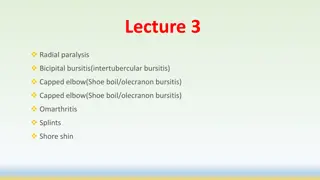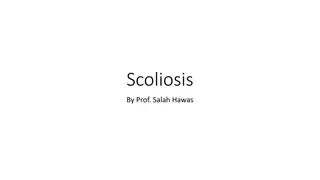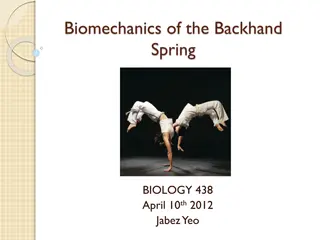Understanding the Elbow Joint Complex and Its Functionality
The elbow joint complex is crucial for both mobility and stability of the hand, serving a uniaxial diarthrodial joint of hinge type with one degree of freedom of motion. Composed of the humeroulnar, humeroradial, proximal radioulnar, and distal radioulnar joints, it articulates surfaces such as the trochlea of the humerus and trochlear notch of the ulna. The joint is supported by a large capsule and ligaments, allowing for flexion and extension movements in the sagittal plane around a coronal axis.
Download Presentation

Please find below an Image/Link to download the presentation.
The content on the website is provided AS IS for your information and personal use only. It may not be sold, licensed, or shared on other websites without obtaining consent from the author. Download presentation by click this link. If you encounter any issues during the download, it is possible that the publisher has removed the file from their server.
E N D
Presentation Transcript
Dr Payal Dhawale Dept. Of Sports Physiotherapy MGM Institute Of Physiotherapy Chh. Sambhajinagar
The joints & muscles of elbow complex serve an important mobility as well as stability function for the hand role to provide Uniaxial diarthrodial joint of hinge type with 1 degree of freedom of motion
The elbow complex includes the elbow joint (humeroulnar and humeroradial joints) and the proximal and distal radioulnar joints elbow and forearm respectivily.
Articulating Surfaces 1. Humeroulnar jt. Concave trochlear notch of ulna Convex trochlea of humerus 2. Humeroradial jt. Conave Fovea of head of radius Convex Spherically shaped capitulum
The Capsule is large ,loose and weak anteriorly but ligaments reinforce from its sides Attachments - anterior, posterior, medial, lateral
2 main ligaments Medial Collateral Ligament Lateral collateral Ligament
The elbow joint is considered to be a compound joint that functions as a modified or loose hinge joint.
One degree of freedom is possible at the elbow, permitting the motions of flexion and extension, which occur in the sagittal plane around a coronal axis.
A slight bit of axial rotation and side-to- side motion of the ulna occurs during flexion and extension, and that is why the elbow is considered to be a modified or loose hinge joint rather than a pure hinge joint.
Two major ligaments and five muscles are directly associated with the elbow joint. Three of the muscles are flexors that cross the anterior aspect of the joint. The other two muscles are extensors that cross the posterior aspect of the joint.
Extension triceps brachii and anconeus Flexion brachialis, biceps brachii, brachioradialis
1. Medial Collateral Ligament 3 parts a. Anterior b. Posterior c. Transverse/Oblique
Anterior Fibers :strongest & stiffest Arise from anterior aspect of medial epicondyle & insert on medial part of coronoid process of ulna Consists of 3 anatomically & functionally distinct fibers based on proximal attachment
Fibers arising from anterior surface of medial condyle taut in full extension Fibers arising from below tip of medial epicondyle taut in 90 flexion to full flexion Fibers arising from inferior edge of medial epicondyle always taut throughout full ROM
Anterior portion of the MCL is considered to be the primary stabilizer of the elbow to valgus stress in the range of elbow flexion from 20-120 deg of flexion Primary restraint to valgus at 30 , 60 , and 90 of flexion Coprimary restraint to valgus at 120 of flexion
Attachment Originate - Posterior part of medial epicondyle Insert - Medial margin of olecranon & coronoid process Primary restraint to valgus at 120 of flex & secondary restraint at 30 & 90 of flexion Function Becomes taut in extremes of elbow flexion & so limits extension Prevents posterior translation of radial head
Cross from olecranon to coronoid process of ulna Since they originate & insert on same bone , they don t provide significant articular stability
Lateral Radial Collateral Ligament Lateral Ulnar Collateral Ligament Annular Collateral Ligament Originates on lateral epicondyle & immediately splits into 2 fiber bundles
Fan shaped That extend from inf aspect lateral epicondyle of the humerous to merge with the annular ligament
MCL All fibers stabilize against the valgus stress at elbow LCL All fibers stabilize against the varus stress at elbow
One degree of freedom Flexion: 135 to145 Passive flexion: 150 to 160 Extension: -5 (hyperextension) Functional Range: 30-130
Carrying angle Males 0-5 deg Females - 10-15 deg Cubitus valgus/varus
Axis of motion Axis for flexion & extension is relatively fixed & passes through the centre of trochlea & capitulum bisecting the longitudnal axis of shaft of humerus
At Humeroulnar jt Flexion Concave surface of trochlear notch rolls & slides anteriorly on convex trochlea Full pasive elbow elongation of the Posterior capsule, extensor ms, ulnar nerve, post fibres of MCL Extension - vice versa flexion requires
At Humeroradial jt There is rolling & sliding of fovea of radius across convexity of capitulum Provides minimal structural stability to elbow jt ,however, provides an imp bony resistance against a valgus force
Functions of elbow muscles : Elbow flexors A. Role of elbow flexors is determined by number of factors Location of muscles Position of elbow & adjacent joints Position of forearm Magnitude of applied load Speed of motion Type of muscle contraction
Mobility ms insertion close to jt axis Average physiologic cross-section of 7 cm2 ,the largest of any ms crossing the elbow generates the greatest force of any ms crossing the elbow, so active in all types of contraction
Work horse of elbow flexion as it is active in all positions ,all speeds & against maximal /minimal resistance MA is greatest at slightly > 100 of elbow flexion Not affected by change in position of forearm / shoulder, so active in all positions
Biceps Brachii Mobility ms insertion close to jt axis MA is largest between 80 -1000 of elbow flexion In full elbow extension msl force is compressive Beyond 100 flexion , acts as a distracting force Affected by change in position of shoulder & elbow
Inserted away from jt axis-stability ms Peak MA occurs between 100- 120 of elbow flexion More active in midprone position Not affected by change in position of forearm/shoulder
Maximal torque produced by elbow flexors : depends on 2 factors Muscles maximal flexion force potential eg. Brachialis Internal moment arm length eg. elbow flexion with forearm in supination
1. Triceps Brachii 2. Anconeus Anconeus usually 1st to initiate & maintain low level extension forces Next , medial head of triceps followed by lateral head & long head of triceps Medial head work horse of extensors Long head Reserve elbow extensor
Effectiveness of triceps is affected by change in position of shoulder but not by changes in position of forearm Maximal isometric torque is generated at elbow 90 flexed
Effectiveness of triceps is affected by change in position of shoulder but not by changes in position of forearm Maximal isometric torque is generated at elbow 90 flexed
The radioulnar joints are two locations in which the radius and ulna articulate in the forearm: Proximal radioulnar joint Distal radioulnar joint
Proximal radioulnar joint: This is located near the elbow, and is an articulation between the head of the radius, and the radial notch of the ulna.
Distal radioulnar joint: This is located near the wrist , and is an articulation between the ulnar notch of the radius, and the ulnar head.
Both of these joints are classified as pivot joints, responsible for pronation and supination of the forearm.
Articulating surfaces - Concave radial notch - Head of radius - Annular ligament - Capitulum of humerus
Articulating surfaces - Ulnar notch of radius - Head of ulna - Articular disk























